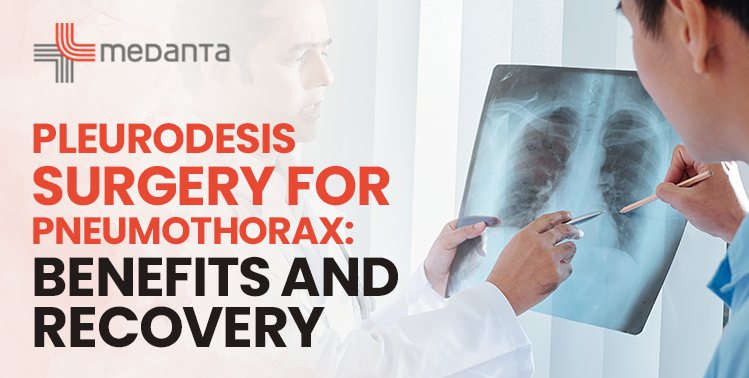CH Baktawar Singh Rd, Medicity, Islampur Colony, Sector 38, Gurugram, Haryana 122001

15 July, 2025
adminPneumothorax, commonly known as a collapsed lung, is a potentially serious medical condition where air leaks into the space between the lungs and the chest wall, preventing the lung from fully expanding. While some cases resolve with minimal intervention, recurrent or severe pneumothorax may require a more permanent solution. This is where pleurodesis surgery becomes a vital option, often performed by experienced thoracic surgeons like Dr Harsh Vardhan Puri.
Pleurodesis is a medical procedure designed to prevent the recurrence of pneumothorax by eliminating the space where air or fluid can accumulate. If you or a loved one is facing recurrent lung collapses or dealing with u nderlying lung disease, consulting with experts such as Dr Harsh Vardhan Puri and understanding the role of pleurodesis could offer clarity and peace of mind. This blog delves into what pleurodesis is, its benefits, and what to expect during recovery.
Pleurodesis is a procedure that intentionally causes the pleural layers (the linings of the lungs and chest wall) to stick together. Normally, these layers are separated by a small amount of lubricating fluid, allowing the lungs to expand and contract smoothly during breathing. In the case of a pneumothorax, air accumulates in this space, disrupting normal lung function.
Pleurodesis works by eliminating this space, thereby preventing future air or fluid accumulation. This is achieved either chemically or surgically:
Pleurodesis isn’t typically the first line of treatment for pneumothorax, especially if it’s the patient’s first episode. However, it may be recommended in the following situations:
The decision to undergo pleurodesis is made after evaluating the frequency of episodes, the patient’s overall health, and the potential impact on quality of life.
Both methods aim to achieve the same result—obliteration of the pleural space—but the surgical approach offers direct access and a higher success rate, especially in complicated or recurrent cases.
The key advantage of pleurodesis is its effectiveness in preventing recurrent pneumothorax. But there are several other benefits worth considering:
Pleurodesis provides a more permanent solution for those who experience multiple lung collapses. For many, it eliminates the fear of recurrence and the disruption that repeated hospital visits can cause.
People living with chronic respiratory conditions often f nd relief in knowing that their lungs are more stable. Pleurodesis can significantly reduce anxiety associated with breathing difficulties or unexpected lung collapse.
The availability of video-assisted thoracoscopic surgery (VATS) means that patients can benefit from shorter hospital stays, less postoperative pain, and faster recovery compared to traditional open surgery.
Once the procedure is completed and the lung has re-expanded successfully, most patients can expect a relatively quick discharge. This not only reduces healthcare costs but also allows patients to return to normal life faster.
Also Read: What Is Pneumothorax Surgery Cost In India?
As with any medical procedure, pleurodesis does come with some risks. These include:
While complications are uncommon, it’s essential to discuss your full medical history with your healthcare provider to assess your individual risk.
Most patients stay in the hospital for a few days after the procedure. The chest tube remains in place until the lung fully re-expands and air or fluid stops leaking. Your medical team will monitor vital signs, pain levels, and lung function closely.
It’s common to experience some chest pain or discomfort following the procedure. Doctors typically prescribe medications to help manage pain and inflammation. Walking and deep-breathing exercises are encouraged to speed up healing.
Patients are usually advised to avoid strenuous activity or heavy lifting for a few days post-surgery. Light activities can resume soon after discharge, but full recovery may take several days depending on the individual.
Regular follow-ups, including chest X-rays, are necessary to ensure the lung remains inflated and no complications have occurred. If surgical pleurodesis was performed, your surgeon will check incision sites for proper healing.
Also Read: Pneumothorax Treatment in Delhi
The success rate of pleurodesis particularly the surgical form is high, with most patients experiencing no recurrence of pneumothorax. For those with underlying lung disease, the procedure can also help in managing symptoms and improving respiratory function.
Importantly, pleurodesis does not cure underlying lung conditions but acts as a preventive strategy against the complications of those conditions. This makes it a valuable tool in the long-term management of respiratory health.
Pleurodesis is a safe, effective, and often life-changing procedure for individuals suffering from recurrent pneumothorax or related complications. Whether performed chemically or surgically, it serves as a crucial intervention to prevent lung collapse, reduce hospitalizations, and improve quality of life.
If you’re dealing with repeated episodes of pneumothorax, consult with a pulmonologist or thoracic surgeon, Dr Harsh Vardhan Puri. Together, you can weigh the pros and cons and determine if pleurodesis is the right path forward.
Remember: While the idea of surgery can be intimidating, taking control of your lung health with the guidance of experts such as Dr Harsh Vardhan Puri can empower you toward a safer and more stable future.
Category : Pneumothorax
Tags: